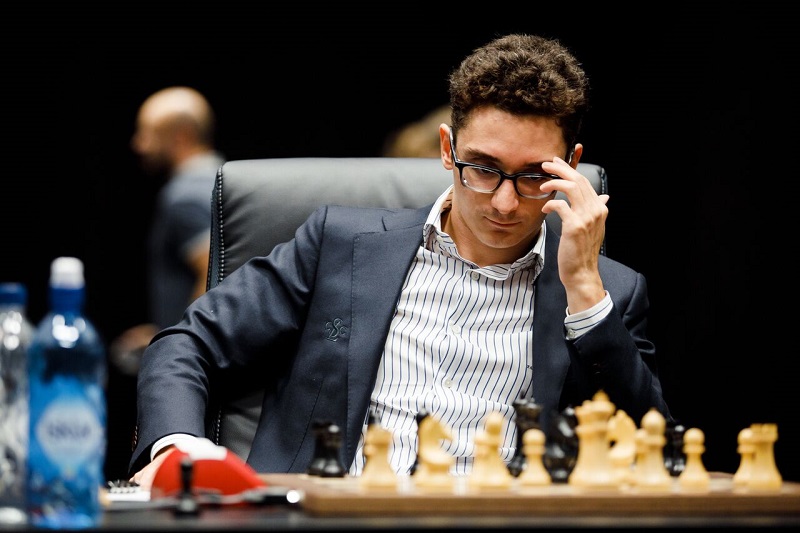


The Petroff (or Russian) Defence which is characterised by the moves 1.e4 e5 2.Nf3 Nf6 has been popular at the highest levels for many years and enjoys the reputation of being an extremely solid defence.
"In long endgames, I still think I have an advantage against Caruana. He can work on it, but I don't think he can equalise my edge in only a few months", said Carlsen in an interview shortly before the match started. In fact, that has been the Norwegian's bread and butter in the past: to find tiny advantages and pressure his opponents endlessly. However, this Friday at The College, he found himself on the opposite side, defending an inferior position in a game that lasted six and a half hours. And he succeeded at it.
After the marathon, the match is still tied and the tension keeps rising. Carlsen has experience in this situation, as he drew the first seven games of his New York match against Karjakin. And if we look back in history, two World Championship matches started with six draws and broke the standstill in game seven — Petrosian vs Spassky 1966 and Anand vs Gelfand 2012. In both cases, the defending champion kept his crown.
For Carlsen, it is not obvious to think that his second straight White will give him an advantage in the next game, as Black has been at the forefront so far in the match. Moreover, it will be interesting to see what first move he will choose on Sunday — after having played 1.d4, 1.c4 and 1.e4 so far, will he 'keep the trend' by playing 1.Nf3?

Carlsen signals 1.e4
Powerplay 26: Checkmate Challenge — essential knowledge
Checkmate. That's the aim of the game. There are numerous ways to checkmate the enemy king, but there are common patterns that recur over and over again, and having these at our mental fingertips is essential for when we want to finish the game.
GM Daniel King provides a 5-minute look at the main events of the day:
Before game four, a video that revealed information about Caruana's preparation was leaked online. It remains to be known whether that was a slip-up or a "hoax", but former World Champion Vishy Anand already gave a sensible answer to the whole controversy:
There's nothing that dramatic that they gave away, except that you confirm that you're looking at the Petroff. On the other hand, this is completely useless information, if the Carlsen team — even if they felt that it's authentic — would they trust it, would the bet their life on it? They can't.
It is funny that he precisely mentioned the Petroff just before it was played, but it was certainly no big surprise for anyone who has followed elite chess events in the last couple of years — an essential component of Caruana's success has been his effective use of this Defence. In game six, the players explored a sideline in which knights are the protagonists:
Master Class Vol.8: Magnus Carlsen
Scarcely any world champion has managed to captivate chess lovers to the extent Carlsen has. The enormously talented Norwegian hasn't been systematically trained within the structures of a major chess-playing nation such as Russia, the Ukraine or China.
This position is relevant insofar, after 14 moves, White has made knight moves nine times and Black has done the same ten times. Here, Magnus developed the first non-knight piece with 15.Bd3 (the queens were exchanged on move 8). The slow opening seemed to indicate that the players were ready to sign a draw in the near future. However, on move 21, Fabiano opened up the centre with 21...c5 and a sharper struggle ensued.

Magnus had to work hard to get the half point
Fabiano started putting pressure on Magnus, and the latter eventually decided to give up a piece for three pawns (although later, he would lose two of them). Carlsen put up a fortress that, according to computers, could have been broken with an unlikely move. Former World Champion Garry Kasparov considered it unthinkable for a human to find the manoeuvre suggested by the silicon monsters:
How I became World Champion Vol.1 1973-1985
Garry Kasparov's rise to the top was meteoric and at his very first attempt he managed to become World Champion, the youngest of all time. In over six hours of video, he gives a first hand account of crucial events from recent chess history, you can improve your chess understanding and enjoy explanations and comments from a unique and outstanding personality on and off the chess board.
The computer shows Black wins with 68..Bh4 here. But had Caruana played the incredible 69.Bd5 Ne2 70.Bf3 Ng1!! they would request metal detectors immediately! No human can willingly trap his own knight like that. pic.twitter.com/ypBjXv3QCA
— Garry Kasparov (@Kasparov63) 16 de noviembre de 2018
The peace treaty was signed on move 80.
Experienced chess trainer and chess author Efstratios Grivas reviews the first half of the match, starting with Game 6. "The game looked like another dull case in the start", he writes, "but quickly moved to a classic one! And what an endgame surprise by the great Magnus!"
Click or tap a game in the game list to switch games
Chess Expertise Step by Step Vol. 1: Unexpected Tactics
Tactics in chess are sequences of moves which limit the opponent’s options and may result in a tangible gain by force. They are usually contrasted with strategy, in which advantages take longer to be realised and where the opponent is less constrained in his choice of reply. This series covers important sections of this field and helps to understand in depth the proper handling of (unexpected) tactics.
Make life difficult for the Sicilian! 2.b3 is a thoroughly venomous but still solid kind of "Anti-Sicilian". No matter what setup black chooses, the bishop on b2 will always be unpleasant for him.